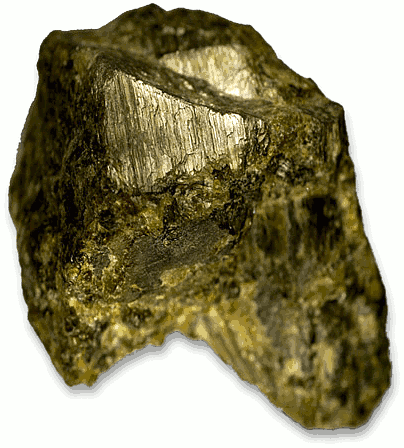| Crystal system | Orthorhombic |
| Transparency | Transparent to opaque |
| Luster | Vitreous ( pearly on cleavage surface) |
| Fracture | Uneven |
| Cleavage | Distinct prismatic |
| Specific Gravity | 3.25-3.45 |
| Hardness | 5.5 |
| Optical Character | Biaxial + ; Double Refractive |
| Refractive index | 1.658-1.668 |
| Birefringence | 0.010 |
| Dispersion | |
| Fluorescence | |
| Pleochroism | Weak |
| Chemical Formula | (Mg, Fe)SiO3 |
| Comments | |
| Streak | White to grayish |
Enstatite (EN-stah-tite) is another member of the pyroxene group, together with diopside, spodumene and jadeite. Its chemical composition is similar to that of diopside, except for the calcium present in diopside, but it crystallizes in the orthorhombic system rather than the monoclinic system. Its formula is (Mg, Fe)SiO3. Like diopside, pure enstatite would be colorless; however, since iron is always present in some degree, it is usually brawn or green. The name of the mineral comes from the Greek word for "adversary", because of its refractory nature.
Other varieties of non gem quality are yellow, gray or white and usually translucent to opaque. It grades into the iron-rich member of the pyroxene family, hypersthene (HY-per-sthene). This word is derived from the Greek meaning "very tough", which is similar in significance to the word "adversary". Hypersthene has higher refractive indices and specific gravity than enstatite; it has a metallic, iridescent effect caused by minute inclusions of another mineral. More or less between the two is a variety called bronziti, which is usually a brownish color with a multitude of fibrous inclusions that give it a bronzy appearance, somewhat similar to black star sapphire in the rough. Both of these materials have more interest as ornamental stones than as gems.
Enstatite first found a certain amount of interest when it was found with diamonds in the blueground of South Africa. Here its green color is enriched in part by the presence of chromium. Although the stones have a lovely color, they are very small; this, plus an easy cleavage and low hardness, have presented them from becoming popular for gem purposes. Enstatite has also been found in the Mogok, Burma, area. Usually, it is a constituent of basic igneous rocks or rocks derived there from. Dark-brown stones have been found in considerable quantities in the state of Karnataka, India.
Enstatite occurs in prismatic crystals in the orthorhombic system, but it is usually massive and fibrous or lamellar. Hypersthene is usually foliated; it, too, is orthorhombic in crystal structure. Both minerals have a hardness of about 5 1/2 and a poor toughness, because of a distinct prismatic cleavage. The fracture is uneven and the streak is white to grayish. No characteristic inclusions have been noted. The luster is vitreous, although a pearly luster is sometimes evident on cleavage surfaces. The mineral has an S.G. of about 3.25, increasing to a high of 3.40 to 3.50 for hypersthene. The R.I. of gem-quality material is usually about 1.658-1.668, and the green gem material is 1.665 - 1.674. The birefringence is near .010. Pleochroism is weak in enstatite and distinct in hypersthene. At the iron-poor end, hypersthene shows indices of 1.673 and 1.683; at the iron-rich end, from 1.715 - 1.731. In other words, the birefringence varies from about .010, when the composition is close to that of enstatite, to about .016 at the upper end of the scale. Enstatite is almost infusible and is insoluble in hydrochloric acid.
It is not too difficult to separate enstatite from most of the other gem stones with which it may be confused. The stone most likely to cause confusion is kornerupine, but it can be distinguished rather readily because it is very strongly negative in sign and strongly pleochroic, in contrast to the weak pleochroism of enstatite. The remarkable absorption spectrum of enstatite, with the intense line at 5060 A.U., serves to identify this mineral conclusively.
Enstatite polishes satisfactorily on a tin lap using Linde A as
the polishing agent. Both the step and brilliant styles are used.
43° crown angles and 39° pavilion angles are recommended.
Hypersthene and bronzite are always cut in the cabochon form.
Enstatite is not a gem of great value, even to collectors; for the
most part, it brings very low prices per carat. It is rarely seen in
cut form, except in occasional miscellaneous parcels from Mogok,
Burma. A lovely dark green cat's-eye pyroxene found in India is
often called enstatite cat's eye, but it is a variety of diopside.


